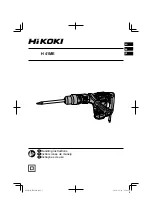
- 4 -
DESCRIPTION
1. Trigger
2. Lock-on button
3. Hex. socket head bolt
4. Roller guide
5. Hex. key wrench
6. Dust nozzle
7. Hex. socket head bolt
8. Base
9. Speed control dial
10. Angle scale
11. Selector lever
SPECIFICATIONS
Cutting capacities
In wood
65 mm
In steel
6 mm
Input
650 W
Strokes per minute
800 - ,000 min
-1
Overall length
15 mm X 00 mm X 70 mm
Net weight
1.8 kg
* Be sure to check the rating label on the product, because the
voltage is subject to change depending on the area in which
the product is to be used.
STANDARD ACCESSORIES
Jig saw blade, Hex. key wrench, Dust nozzle
APPLICATIONS
(Use only for the purposes listed below.)
1. Cutting wood, resin boards and thin metal sheets.
BLADE INSTALLATION (Fig. 1, 2)
BE SURE TO DISCONNECT THE PLUG FROM THE POWER
SOURCE BEFORE INSTALLING THE BLADE.
1. Loosen the hex. socket head bolts (3) by using the hex. key
wrench (5).
2. Insert the blade completely into the spindle slot.
3. Tighten the hex. socket head bolts.
The hex. key wrench is stored in the holder on the cord-strain
reliever. When not using the hex. key wrench, store it in the
designated place.
NOTE!
Check that the back of the jig saw blade enters the groove of
the roller guide (4).
ORBITAL ACTION (Fig. 3)
To obtain the best cutting action with various types of material,
it is necessary to adjust the orbital action of the saw blade. This
tool has a selector lever (11) on the side of the housing.
Selections range from 0 for straight reciprocating blade action to
for largest orbit of the blade.
When cutting into wood and plastic or other soft materials, a large
swing is required, i.e. position
, or
.
For steel and similar hard materials, the cutting action should not
be so great, so position 0 should be used.
However, if a sharp and precise cutting surface is required for
soft materials, then position 0 may also be used.
It is also intended for thin materials, as well as for knife or rasp
work.
SWITCH (Fig. 4, 5)
This tool is started and stopped by squeezing and releasing the
trigger (1).
For continuous operation, press the lock-on button () while the
trigger is squeezeded. Depress the trigger again to release the
lock.
This tool operates at speeds in the range of 800 – ,000min
-1
.
The speed control dial (9) permits adjustments while the tool is
running and allows operation at the desired speed.
The general rules for cutting speed apply: the harder the material
(steel), the lower the speed: the softer the material (wood), the
higher the speed.
DUST NOZZLE (Fig. 6)
While operating the tool, the dust nozzle (6) should be connected
to a vacuum cleaner.
(The dust nozzle can be connected to a vacuum cleaner with a
hose outer diameter of 34.5mm.)
OPERATION
NEVER COVER THE AIR VENTS SINCE THEY MUST ALWAYS
BE OPEN FOR PROPER MOTOR COOLING.
STARTING (Fig. 7)
For accurate cutting, hold the tool at right angles to the work.
Hold the base of the tool in firm contact with the work.
ARC CUTTING
In cases of small circle or arc cutting, use a lower cutting speed
than for ordinary straight cutting.
NOTE!
Too much pressure may break the blade when cutting in a
circular motion.
METAL CUTTING
Protective glasses should be used to protect the operator’s eyes.
Cutting oil or emulsion for steel, and turbine oil for non-metallic
materials like aluminum should be used.
CENTER CUTTING (Fig. 8)
To cut in the center of a board, rest the base of the tool on the
board as shown in fig. 7, so that the blade does not touch it. Then
turn the switch on and slowly lower the moving blade against the
board.
For materials other than wood, a starting hole must be drilled first.
BEVEL CUTTING (Fig. 9, 10)
Loosen the hex. socket head bolt (7) at the bottom of the base by
using the hex. key wrench (5). Next align the bottom line of the
housing to the angle scale (10) on the base plate, and then fasten
the hex. socket head bolt firmly. Bevel cutting of 0 - 45° can be
achieved easily.
MAINTENANCE
After use, check the tool to make sure that it is in top condition.
It is recommended that you take this tool to a Ryobi Authorized
Service Center for a through cleaning and lubrication at least
once a year.
DO NOT MAKE ANY ADJUSTMENTS WHILE THE MOTOR IS
IN MOTION.
ALWAYS DISCONNECT THE POWER CORD FROM THE
RECEPTACLE BEFORE CHANGING REMOVABLE OR
EXPENDABLE PARTS (BLADE, BIT, SANDING PAPER ETC.),
LUBRICATING OR WORKING ON THE UNIT.
WARNING!
To ensure safety and reliability, all repairs should be
performed by an AUTHORIZED SERVICE CENTER or other
QUALIFIED SERVICE ORGANIZATION.
Содержание J-650V
Страница 1: ...6986195 STD 11 10 J 650V...
Страница 2: ...5 3 1 2 3 2 1 4 9 1 2 6 8 5 4 11 11 4...
Страница 3: ...5 6 9 7 10 6 2 9 8 45 30 15 0 10 7 5...
Страница 6: ...NOTE...
Страница 7: ...NOTE...


























